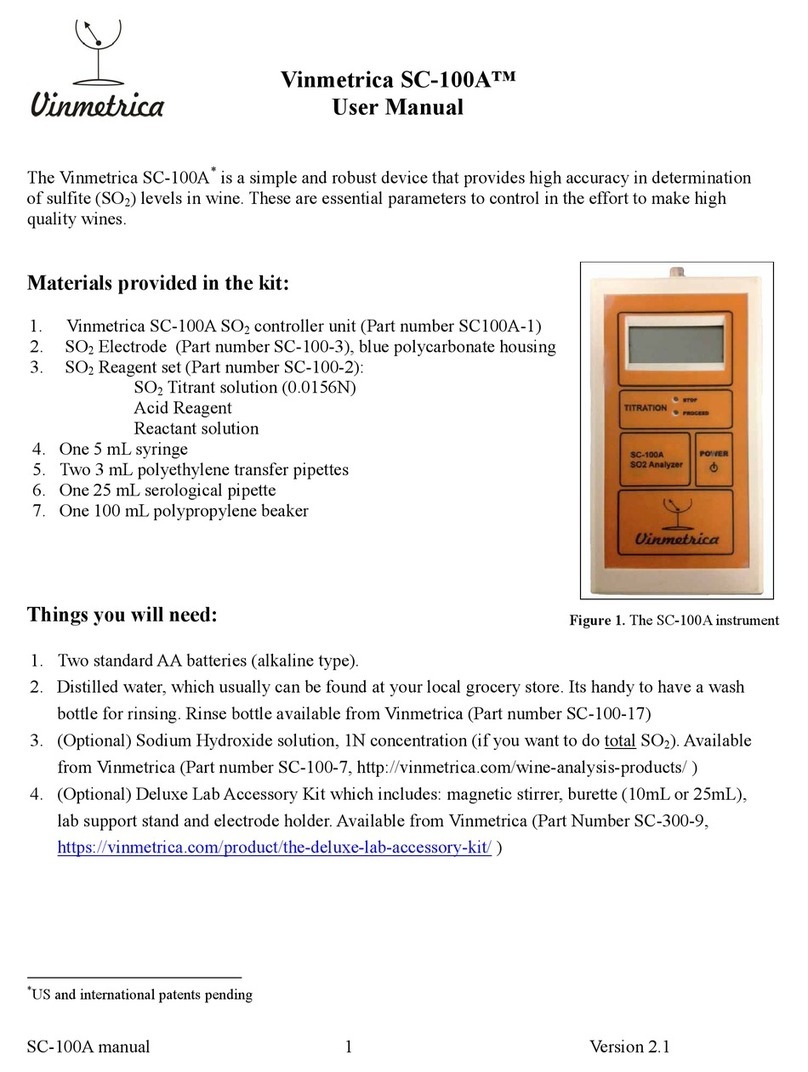
SC-300 Pro Kit Manual 10 Version 2.2
Before beginning the titration, record the starting titration volume, using the thick white paper
with the black band, and then begin titrating, slowly. With enough practice, you will eventually be able
to read the burette without black banded paper. Record the final titration volume using the same
technique. You can also checkout these websites for more burette info:
http://www.titrations.info/pipette-burette or http://www.csudh.edu/oliver/demos/buretuse/buretuse.htm
Instrument Operation:
1. Turn on the instrument by pressing the POWER button briefly (Note: depressing the POWER
button longer than two seconds at start-up will cause the instrument to enter Test Mode; see
Appendix A). The instrument will go through a power-up sequence. After a few seconds the
instrument will start in whatever mode was last selected. The mode is indicated by the yellow
LED panel on the left. Select the desired mode by pressing the MODE button.
2. SO2mode: This is for determining ppm of SO2 by titration (see below under ‘Procedures’) and
the SO2 electrode must be used. As a safety precaution, you must press the ENTER button after
selecting SO2mode to confirm that the SO2electrode is attached before the mode will be
enabled. However, scrolling through the MODE selections (such that you pass by the SO2
selection) with a pH electrode attached is safe, as long as you do not press ENTER to confirm
the SO2mode. After pressing ENTER, you should see the display show a value less than 50
(usually 0.0) and the green "PROCEED" LED should be on. Make sure to attach the SO2
electrode. Note: On older style, single connector units (pre-2014), the pH electrode can be
damaged by connecting it to the instrument in SO2 mode.
3. pH mode: In this mode, the meter measures the pH. The pH electrode must be attached. If the
instrument has not yet been calibrated, the message “doCal” scrolls across the screen, and you
need to do a calibration (see Calibration of pH below). We recommend re-calibrating the
instrument for pH once each day of use. Warning: Be careful not to press ENTER when the pH
electrode is attached while the instrument is in SO2mode, as this can potentially damage the pH
electrode. If this does happen, and the pH electrode does not respond correctly, place it into the
pH 4 Reference solution for an hour and it should return to normal function.
4. Potential mode (Firmware version 3.1.1 and higher) (pH LED flashing): In this mode the
instrument displays the potential in volts, (or millivolts in version 3.1.2 and above) coming
from an electrode attached to the pH connector. This can be used with certain electrodes, for
example, Vinmetrica’s Dissolved Oxygen System, ORP, potassium, or sodium electrodes, or to
view the raw voltage reading of a pH electrode. In this mode, when the red STOP LED is
illuminated, the values on the screen are negative; otherwise the values are positive.
5. TA mode: This is for titration in determining titratable acidity (TA). As in the pH mode, the pH
is displayed and the pH electrode must be attached. The green (“PROCEED”) LED is lit if the
pH is below the TA endpoint (normally 8.2, but can be set to 7.0, see Appendix A, Test Mode,


































